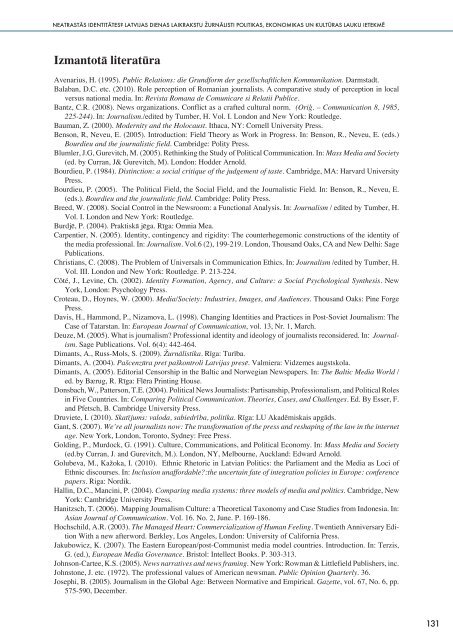ilze-sulmane-neatrastas-identitates
ilze-sulmane-neatrastas-identitates
ilze-sulmane-neatrastas-identitates
You also want an ePaper? Increase the reach of your titles
YUMPU automatically turns print PDFs into web optimized ePapers that Google loves.
NEATRASTĀS IDENTITĀTES? LATVIJAS DIENAS LAIKRAKSTU ŽURNĀLISTI POLITIKAS, EKONOMIKAS UN KULTŪRAS LAUKU IETEKMĒ<br />
Izmantotā literatūra<br />
Avenarius, H. (1995). Public Relations: die Grundform der gesellschaftlichen Kommunikation. Darmstadt.<br />
Balaban, D.C. etc. (2010). Role perception of Romanian journalists. A comparative study of perception in local<br />
versus national media. In: Revista Romana de Comunicare si Relatii Publice.<br />
Bantz, C.R. (2008). News organizations. Conflict as a crafted cultural norm. (Oriģ. – Communication 8, 1985,<br />
225-244). In: Journalism./edited by Tumber, H. Vol. I. London and New York: Routledge.<br />
Bauman, Z. (2000). Modernity and the Holocaust. Ithaca, NY: Cornell University Press.<br />
Benson, R, Neveu, E. (2005). Introduction: Field Theory as Work in Progress. In: Benson, R., Neveu, E. (eds.)<br />
Bourdieu and the journalistic field. Cambridge: Polity Press.<br />
Blumler, J.G, Gurevitch, M. (2005). Rethinking the Study of Political Communication. In: Mass Media and Society<br />
(ed. by Curran, J& Gurevitch, M). London: Hodder Arnold.<br />
Bourdieu, P. (1984). Distinction: a social critique of the judgement of taste. Cambridge, MA: Harvard University<br />
Press.<br />
Bourdieu, P. (2005). The Political Field, the Social Field, and the Journalistic Field. In: Benson, R., Neveu, E.<br />
(eds.). Bourdieu and the journalistic field. Cambridge: Polity Press.<br />
Breed, W. (2008). Social Control in the Newsroom: a Functional Analysis. In: Journalism / edited by Tumber, H.<br />
Vol. I. London and New York: Routledge.<br />
Burdjē, P. (2004). Praktiskā jēga. Rīga: Omnia Mea.<br />
Carpentier, N. (2005). Identity, contingency and rigidity: The counterhegemonic constructions of the identity of<br />
the media professional. In: Journalism. Vol.6 (2), 199-219. London, Thousand Oaks, CA and New Delhi: Sage<br />
Publications.<br />
Christians, C. (2008). The Problem of Universals in Communication Ethics. In: Journalism /edited by Tumber, H.<br />
Vol. III. London and New York: Routledge. P. 213-224.<br />
Côté, J., Levine, Ch. (2002). Identity Formation, Agency, and Culture: a Social Psychological Synthesis. New<br />
York, London: Psychology Press.<br />
Croteau, D., Hoynes, W. (2000). Media/Society: Industries, Images, and Audiences. Thousand Oaks: Pine Forge<br />
Press.<br />
Davis, H., Hammond, P., Nizamova, L. (1998). Changing Identities and Practices in Post-Soviet Journalism: The<br />
Case of Tatarstan. In: European Journal of Communication, vol. 13, Nr. 1, March.<br />
Deuze, M. (2005). What is journalism? Professional identity and ideology of journalists reconsidered. In: Journalism.<br />
Sage Publications. Vol. 6(4): 442-464.<br />
Dimants, A., Russ-Mols, S. (2009). Žurnālistika. Rīga: Turība.<br />
Dimants, A. (2004). Pašcenzūra pret paškontroli Latvijas presē. Valmiera: Vidzemes augstskola.<br />
Dimants, A. (2005). Editorial Censorship in the Baltic and Norwegian Newspapers. In: The Baltic Media World /<br />
ed. by Bærug, R. Rīga: Flēra Printing House.<br />
Donsbach, W., Patterson, T.E. (2004). Political News Journalists: Partisanship, Professionalism, and Political Roles<br />
in Five Countries. In: Comparing Political Communication. Theories, Cases, and Challenges. Ed. By Esser, F.<br />
and Pfetsch, B. Cambridge University Press.<br />
Druviete, I. (2010). Skatījums: valoda, sabiedrība, politika. Rīga: LU Akadēmiskais apgāds.<br />
Gant, S. (2007). We’re all journalists now: The transformation of the press and reshaping of the law in the internet<br />
age. New York, London, Toronto, Sydney: Free Press.<br />
Golding, P., Murdock, G. (1991). Culture, Communications, and Political Economy. In: Mass Media and Society<br />
(ed.by Curran, J. and Gurevitch, M.). London, NY, Melbourne, Auckland: Edward Arnold.<br />
Golubeva, M., Kažoka, I. (2010). Ethnic Rhetoric in Latvian Politics: the Parliament and the Media as Loci of<br />
Ethnic discourses. In: Inclusion unaffordable?:the uncertain fate of integration policies in Europe: conference<br />
papers. Riga: Nordik.<br />
Hallin, D.C., Mancini, P. (2004). Comparing media systems: three models of media and politics. Cambridge, New<br />
York: Cambridge University Press.<br />
Hanitzsch, T. (2006). Mapping Journalism Culture: a Theoretical Taxonomy and Case Studies from Indonesia. In:<br />
Asian Journal of Communication. Vol. 16. No. 2, June. P. 169-186.<br />
Hochschild, A.R. (2003). The Managed Heart: Commercialization of Human Feeling. Twentieth Anniversary Edition<br />
With a new afterword. Berkley, Los Angeles, London: University of California Press.<br />
Jakubowicz, K. (2007). The Eastern European/post-Communist media model countries. Introduction. In: Terzis,<br />
G. (ed.), European Media Governance. Bristol: Intellect Books. P. 303-313.<br />
Johnson-Cartee, K.S. (2005). News narratives and news framing. New York: Rowman & Littlefield Publishers, inc.<br />
Johnstone, J. etc. (1972). The professional values of American newsman. Public Opinion Quarterly. 36.<br />
Josephi, B. (2005). Journalism in the Global Age: Between Normative and Empirical. Gazette, vol. 67, No. 6, pp.<br />
575-590, December.<br />
131


